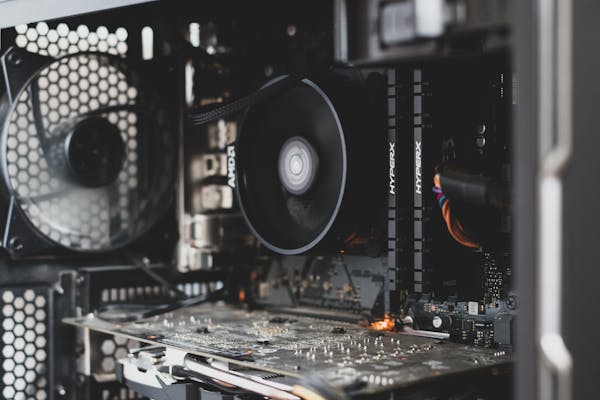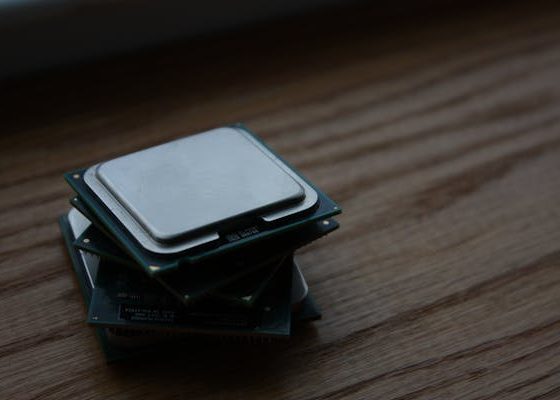The world of computing has seen dramatic shifts over the past few decades, with continuous innovations in both hardware and software. A key player in this evolution has been Advanced Micro Devices (AMD), known for delivering high-performance CPUs that rival the best in the market. The launch of AMD’s latest CPU marks another milestone in the company’s long history of technological excellence.

We will dive deep into AMD’s latest CPU, exploring its architecture, performance benchmarks, power efficiency, and the impact it has on various sectors including gaming, content creation, and professional workloads. We will also examine how AMD’s strategy with this new CPU stands in competition with its rivals, particularly Intel, and what this means for the future of the computing industry.
A Brief History of AMD’s CPUs
To understand the significance of AMD’s latest CPU, we need to look back at the company’s trajectory. Founded in 1969, AMD started as a second-source supplier for Intel’s microprocessors, but it wasn’t long before the company began designing its own chips. Throughout the 1990s and early 2000s, AMD released several successful processors, but it wasn’t until the launch of the Ryzen series in 2017 that AMD truly began to dominate.
The introduction of the Ryzen processors marked a pivotal point for AMD, particularly with the company’s focus on multi-core performance, efficient power consumption, and affordable pricing compared to Intel’s chips. With each subsequent Ryzen generation, AMD refined its architecture and improved performance, ultimately taking a significant share of the desktop, laptop, and server CPU markets.
Now, AMD’s latest CPU takes this legacy forward, pushing the boundaries of computing even further.
Architecture: What’s New?
One of the key factors that sets AMD’s latest CPU apart from its predecessors is its new architecture. The architecture of a processor dictates how efficiently it can process instructions, manage power consumption, and handle complex tasks. AMD has invested heavily in developing cutting-edge architectures that offer both performance and efficiency.
Zen 5 Architecture (speculative, based on trends): AMD’s previous architecture, Zen 4, was known for significant improvements in Instructions Per Cycle (IPC), power efficiency, and multi-threading. With the release of AMD’s latest CPU, which may be based on the anticipated Zen 5 architecture, users can expect further gains in IPC, performance-per-watt, and overall scalability. Zen 5 could incorporate a 3nm or even 2nm process node, shrinking transistor size and improving both power efficiency and performance.
Chiplet Design: Continuing the Trend
AMD has popularized the chiplet design in recent years, an innovative approach that involves using multiple smaller silicon dies rather than one large monolithic die. This design allows AMD to improve yields, reduce costs, and scale performance more effectively. AMD’s latest CPU is expected to continue this design philosophy, with further refinements that optimize inter-chiplet communication and minimize latency.
A key advantage of the chiplet design is that it allows AMD to focus on producing different chiplets optimized for specific tasks, such as CPU cores, cache, and I/O. By doing so, AMD can deliver highly scalable CPUs, perfect for everything from budget gaming rigs to high-end workstations and servers.
Performance Benchmarks
When evaluating a CPU, performance benchmarks provide the most objective way to measure its capabilities. AMD’s latest CPU is expected to dominate the charts, excelling in both single-threaded and multi-threaded workloads.
Single-Core Performance: Competing with the Best
For many applications, single-core performance remains the gold standard for measuring a CPU’s ability to handle intensive tasks, such as gaming and certain types of workloads in professional software like CAD or music production. AMD’s previous-generation CPUs already showed impressive single-core performance gains, narrowing the gap between AMD and Intel.
With AMD’s latest CPU, this trend is expected to continue, potentially surpassing Intel’s best processors. Early benchmarks suggest that improvements in IPC and clock speeds, combined with efficient power management, have given AMD the edge in single-core tasks.
Multi-Core Performance: A Multi-Threading Powerhouse
Where AMD has consistently outperformed Intel in recent years is in multi-core performance. This is crucial for workloads that can take advantage of multiple threads, such as 3D rendering, video editing, and scientific simulations. Thanks to its innovative chiplet architecture and higher core counts, AMD’s latest CPU continues this trend of excelling in multi-threaded workloads.
With applications and software increasingly optimized for multi-threading, having a processor that can handle dozens of cores is essential. Whether you are a professional video editor rendering 4K footage, a data scientist running large-scale simulations, or a gamer streaming and playing AAA titles simultaneously, AMD’s latest CPU is designed to meet the demands of modern multitasking.
Power Efficiency: More Performance, Less Energy
One of the key aspects of AMD’s latest CPU is its focus on power efficiency. As processors become more powerful, balancing performance with energy consumption has become critical, especially in an age where environmental sustainability is a growing concern.
Performance Per Watt
In the race for more performance, AMD has not overlooked energy efficiency. With AMD’s latest CPU, we can expect to see improved performance-per-watt metrics, thanks to the advanced node process and architectural enhancements. This not only reduces electricity costs but also translates to cooler operating temperatures, allowing for quieter systems and more compact form factors. For mobile computing devices, such as laptops, this improvement can lead to longer battery life without compromising performance.
Gaming Performance: Dominating the FPS Charts
For gamers, raw CPU performance translates into higher frame rates, faster load times, and smoother gameplay, particularly when paired with high-end GPUs. AMD’s latest CPU is set to provide top-tier gaming experiences, rivaling or even surpassing Intel’s latest chips in gaming benchmarks.
Gaming at Higher Resolutions
As more gamers move towards higher resolutions like 1440p and 4K, the CPU’s role in gaming becomes even more critical. While lower resolutions rely heavily on the GPU, higher resolutions can bottleneck on the CPU, especially when there are a large number of simultaneous threads being processed, such as during complex AI calculations or in open-world environments.
Thanks to its strong single-core and multi-core performance, AMD’s latest CPU is well-equipped to handle modern gaming demands, particularly when paired with AMD’s own Radeon GPUs for a fully optimized gaming system.
Ray Tracing and AI Acceleration
Modern gaming isn’t just about higher frame rates. The inclusion of technologies like ray tracing and AI-enhanced upscaling, such as AMD’s FidelityFX Super Resolution (FSR), are transforming the visual fidelity of games. AMD’s latest CPU will likely feature improvements to handle these compute-intensive tasks more efficiently, ensuring that gamers can enjoy cutting-edge graphics without sacrificing performance.
Content Creation: A Tool for Professionals
Content creators, from video editors to 3D artists, have increasingly relied on high-core-count CPUs to handle their workloads. Software like Adobe Premiere Pro, DaVinci Resolve, Blender, and Autodesk Maya are all optimized to take advantage of CPUs that can handle multiple threads simultaneously.
Video Editing and Rendering
One of the biggest performance gains with AMD’s latest CPU is likely to be seen in video editing and rendering workflows. These tasks are both CPU and GPU-intensive, and having a processor that can manage multiple 4K or even 8K video streams, complex transitions, and real-time playback is essential.
Early benchmarks indicate that AMD’s latest CPU will offer significant improvements in render times for video production, thanks to its superior multi-core performance. With more creative professionals moving towards higher resolution content, these performance gains are expected to be particularly impactful.
3D Modeling and Animation
3D modeling, texturing, and animation tasks also benefit immensely from multi-threaded performance. As industries like gaming, film, and virtual reality grow, the demand for processors that can handle real-time rendering and complex simulations is increasing. AMD’s latest CPU, with its superior multi-threading capabilities, is expected to become a go-to solution for professionals in these industries.
AI and Machine Learning: Accelerating Innovation
As artificial intelligence and machine learning (AI/ML) become more integral to various industries, CPUs that can handle AI-specific workloads are in high demand. AMD’s latest CPU is expected to feature enhancements specifically designed to accelerate AI/ML tasks, making it a compelling choice for developers and researchers working in AI, data science, and machine learning fields.
AI-Enhanced Workloads
AI-enhanced workloads, such as neural network training and inference, require a high degree of parallelism and efficient compute resources. While GPUs are often the primary drivers of AI workloads, the CPU plays a crucial role in managing data preprocessing, orchestration, and offloading tasks that don’t require the full power of a GPU.
AMD’s innovation in this space, combined with its chiplet design, could position AMD’s latest CPU as an essential component in AI-driven environments, particularly in edge computing and data centers where space and power efficiency are critical.
Competition: AMD vs. Intel – The CPU Wars Continue
The rivalry between AMD and Intel has defined much of the CPU market for decades. Intel, once the uncontested leader in desktop and server processors, has faced significant challenges from AMD in recent years, particularly since the introduction of the Ryzen series.
With AMD’s latest CPU, the competition is set to intensify even further. Intel’s latest offerings, particularly its 13th-gen Core processors, boast strong single-core performance and improved efficiency. However, AMD’s latest CPU is likely to push the envelope in multi-core performance, power efficiency, and price-to-performance ratio.
Pricing Strategy: A Competitive Edge
One of AMD’s key strengths has always been its aggressive pricing strategy. While Intel has historically commanded a premium for its CPUs, AMD’s approach of offering similar or superior performance at a more affordable price point has made it a favorite among consumers looking for value without sacrificing performance. With AMD’s latest CPU, this trend is expected to continue, further solidifying AMD’s position as the price-to-performance leader in the industry.
As the CPU market becomes increasingly competitive, especially with the rise of ARM-based processors in mobile and even desktop environments (such as Apple’s M-series chips), AMD’s ability to deliver high-performance processors at competitive prices is more crucial than ever. AMD’s latest CPU is expected to offer a compelling alternative not only to Intel’s high-end chips but also to other emerging architectures that are gaining ground in specialized markets.
Ecosystem Integration: The AMD Advantage
One of AMD’s key strategies in recent years has been the development of an integrated ecosystem that combines its CPUs with its GPUs, motherboards, and other components. This holistic approach ensures that AMD’s products work seamlessly together, providing users with optimized performance across the board.
AM5 Platform
With the introduction of AMD’s latest CPU, the company has continued to refine its platform support. The AM5 socket, which was introduced with previous Ryzen generations, is designed to support future upgrades, making it a future-proof choice for consumers who want the flexibility to upgrade their CPUs without changing their entire system. The platform also supports cutting-edge technologies like PCIe 5.0, DDR5 memory, and USB4, ensuring that AMD’s latest CPU can take full advantage of the fastest peripherals and memory available.
Synergy with Radeon GPUs
Another important aspect of AMD’s ecosystem is its synergy with Radeon GPUs. By pairing AMD’s latest CPU with one of its powerful Radeon GPUs, users can unlock features like Smart Access Memory (SAM), which allows the CPU to access the GPU’s full VRAM, leading to significant performance gains in gaming and certain professional applications. This level of integration is a major selling point for users who want an all-AMD system that delivers optimized performance out of the box.
Ryzen Master Software
For users who want to push the limits of their hardware, AMD offers Ryzen Master, a powerful overclocking tool that provides granular control over CPU performance. With AMD’s latest CPU, Ryzen Master will likely offer even more customization options, allowing users to fine-tune their CPU’s performance to suit their specific needs, whether it’s for gaming, content creation, or professional workloads.
Impact on Different Market Segments
One of the reasons AMD has been so successful in recent years is its ability to cater to a wide range of market segments. AMD’s latest CPU continues this trend, offering solutions for everyone from casual users to hardcore enthusiasts and enterprise customers.
Consumer Market
In the consumer market, AMD’s latest CPU is positioned as an ideal choice for both gaming enthusiasts and everyday users who want a powerful and future-proof system. With its excellent single-core performance, the CPU is perfect for gaming, while its multi-core capabilities make it a strong contender for users who multitask or run demanding applications like video editing or 3D rendering.
The CPU’s power efficiency is also a major selling point for users who are looking for a quieter and cooler system, especially in compact builds. As more consumers become conscious of their power consumption, AMD’s latest CPU is expected to appeal to a growing market of eco-conscious buyers.
Gaming Market
The gaming market is one of AMD’s most important segments, and AMD’s latest CPU is tailor-made for gamers who demand the best performance possible. With support for high core counts, high clock speeds, and advanced features like Precision Boost 2 and PBO (Precision Boost Overdrive), AMD’s latest chip is expected to deliver top-tier gaming experiences, especially when paired with AMD’s own Radeon graphics cards.
The CPU’s multi-threaded performance is also crucial for streamers who want to broadcast their gameplay while maintaining smooth frame rates. With more gamers turning to platforms like Twitch and YouTube for content creation, AMD’s latest CPU is an ideal choice for those who need both gaming and multitasking power in a single package.
Enterprise and Data Centers
While AMD’s Ryzen series has been a game-changer in the consumer space, the company’s EPYC processors have revolutionized the server and data center markets. AMD’s latest CPU is expected to build on this momentum, offering enterprise customers a scalable, energy-efficient solution for data-intensive workloads like cloud computing, artificial intelligence, and big data analytics.
Thanks to its advanced architecture and power efficiency, AMD’s latest CPU is likely to attract more enterprise clients looking to reduce their operational costs while improving performance. The chip’s ability to handle a wide range of workloads, from virtualization to database management, makes it a versatile choice for businesses that need reliable and scalable computing power.
Future-Proofing: Preparing for Tomorrow’s Workloads
As the computing landscape continues to evolve, one of the key concerns for consumers and businesses alike is future-proofing their hardware. Buying a CPU that will remain relevant and powerful for several years is a crucial consideration, especially as software continues to become more demanding.
Support for DDR5 and PCIe 5.0
One of the ways AMD’s latest CPU addresses future-proofing is through its support for cutting-edge technologies like DDR5 memory and PCIe 5.0. DDR5 offers faster data transfer rates and greater bandwidth compared to DDR4, which is essential for future applications that require large amounts of data processing, such as AI, gaming, and content creation.
PCIe 5.0, on the other hand, doubles the bandwidth of PCIe 4.0, allowing for faster communication between the CPU, GPU, and other peripherals like NVMe SSDs. As new GPUs and storage devices are released that take advantage of PCIe 5.0, AMD’s latest CPU will be able to handle them without bottlenecks, ensuring that your system remains competitive for years to come.
AI and Machine Learning Capabilities
As artificial intelligence and machine learning become more integrated into everyday applications, CPUs that can accelerate these workloads will become increasingly valuable. AMD’s latest CPU is expected to feature hardware-level optimizations for AI and machine learning tasks, ensuring that it can handle the growing demand for AI-enhanced applications in industries like healthcare, finance, and automotive.
By investing in AI capabilities, AMD is positioning itself as a leader in the next wave of computing innovation, ensuring that its CPUs will be able to handle tomorrow’s workloads with ease.
Conclusion:
AMD’s latest CPU represents a major leap forward in the world of computing. With its cutting-edge architecture, improved power efficiency, and exceptional performance across a wide range of applications, this CPU is poised to set new standards in the industry. Whether you’re a gamer, content creator, or enterprise professional, AMD’s latest CPU offers the perfect combination of power, efficiency, and future-proofing to meet your needs.
As the competition between AMD and Intel heats up, AMD’s latest CPU positions the company as a dominant force in the market, continuing the momentum that began with the Ryzen series. With each new generation, AMD proves that it’s not just a contender but a leader in innovation, pushing the boundaries of what CPUs can achieve.
Whether you’re looking to build a new gaming rig, upgrade your workstation, or deploy powerful servers in your data center, AMD’s latest CPU offers a compelling choice that promises to deliver top-tier performance for years to come. This chip is not just an incremental upgrade; it’s a bold statement of AMD’s commitment to innovation and excellence in the ever-evolving world of computing.











